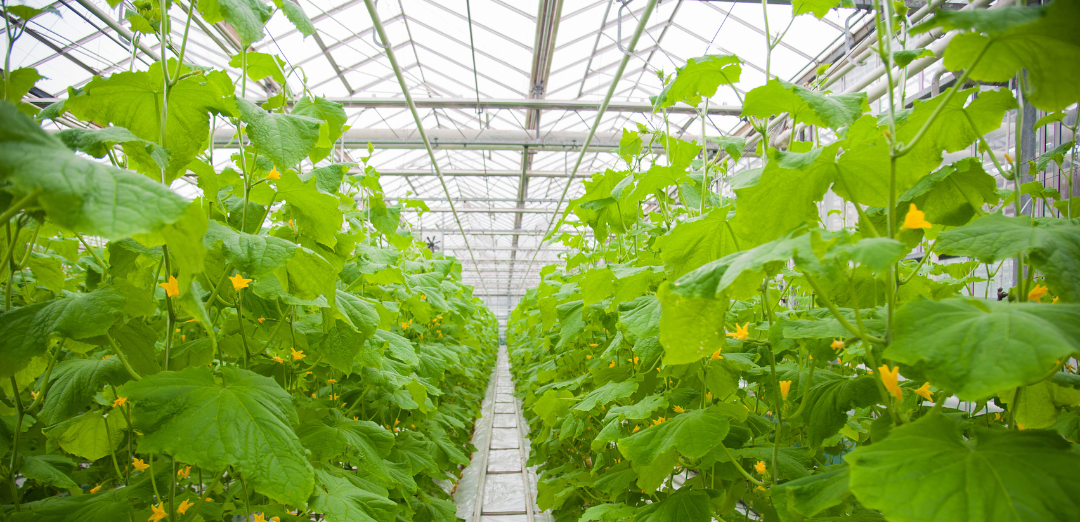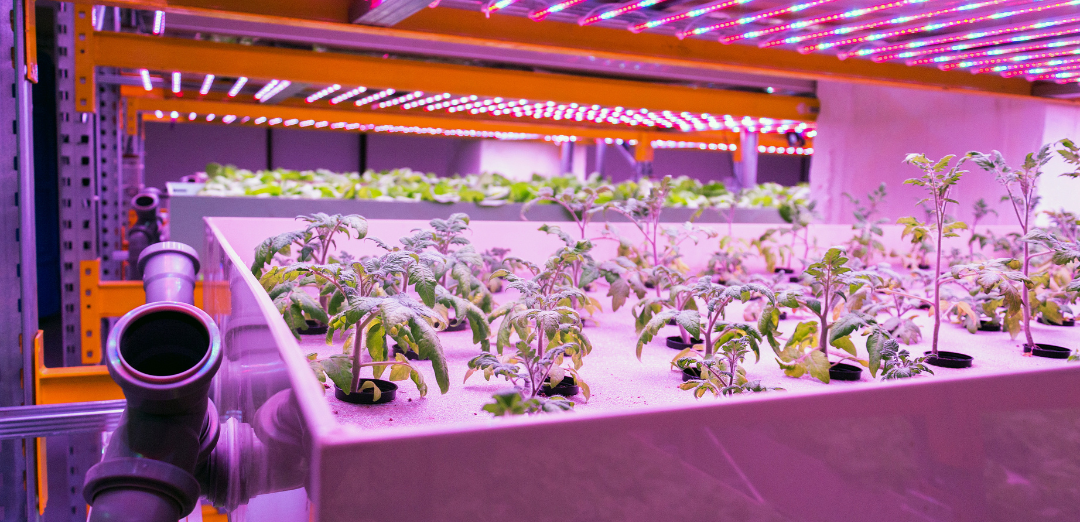
CEA, or Controlled Environment Agriculture, refers to a modern farming approach that utilises technology and controlled conditions to optimise plant growth and crop production. In CEA systems, environmental factors like temperature, humidity, light, and nutrient levels are precisely regulated, often within indoor facilities. This method minimises the impact of external factors such as weather and pests, ensuring year-round crop cultivation and higher yields. CEA is known for its resource efficiency, reduced pesticide use, and potential for sustainable food production in urban areas, making it a key player in addressing global food security and environmental challenges. Different types of CEA range from things like greenhouse farming and windowsill growing, to the more precisely controlled hydroponics, aeroponics, aquaponics and vertical farming.
Greenhouse Farming
Greenhouse farming, also known as glasshouse or hothouse farming, is a controlled environment agriculture method in which crops are cultivated within enclosed structures designed to regulate and optimise environmental conditions. Greenhouses typically have transparent walls and roofs, allowing sunlight to enter while trapping heat inside. These structures enable farmers to carefully control factors such as temperature, humidity, and ventilation, creating an ideal microclimate for plant growth. Greenhouse farming offers several benefits, including the extension of the growing season, protection from adverse weather conditions, and reduced exposure to pests and diseases. It also allows for more efficient resource use, such as water and fertilisers. However, greenhouses have high initial construction and maintenance costs, offer limited control over some environmental factors such as natural light, and are energy-intensive in colder climates. Greenhouses are used to grow a wide variety of crops, including vegetables, fruits, flowers, and herbs, and are essential for year-round production in many regions.
Window Sill Farming
Window sill farming, also known as window gardening or sill gardening, refers to a small-scale gardening practice where plants are cultivated on the window sill of a building, typically in urban or limited space environments. It involves growing a variety of plants, such as herbs, small vegetables, flowers, or ornamental plants, in pots, containers, or planter boxes placed on a windowsill. Window sill farming allows individuals with minimal outdoor space or no access to a garden to engage in gardening and enjoy the benefits of growing their own plants. It makes use of available sunlight and can be a practical and aesthetically pleasing way to incorporate greenery and fresh produce into urban living spaces. This practice is popular among apartment dwellers, city residents, or anyone looking to maximise their available indoor space for gardening.
Hydroponic Farming
Hydroponics is a soilless method of growing plants in which nutrient-rich water solutions directly supply essential minerals and nutrients to plant roots. In this system, traditional soil is replaced with a growing medium, such as coconut coir, perlite, or vermiculite, to support the plants. Plant roots are immersed or irrigated with a carefully balanced nutrient solution, and the environment, including temperature, humidity, and light, is closely controlled. Hydroponics offers several advantages, including faster growth rates, increased crop yields, and efficient water and nutrient use. On the other hand, hydroponic systems have high initial setup and maintenance costs, require a reliable power source for pumps and nutrient delivery, and are sensitive to pH and nutrient imbalances. Hydroponics are widely used in commercial agriculture and are also popular among hobbyists and urban gardeners. Different hydroponic systems, such as deep water culture, nutrient film technique, and aeroponics, allow for various approaches to soilless plant cultivation, making it a versatile and sustainable method of agriculture.

Aeroponic Farming
Aeroponics is an advanced soilless method of plant cultivation in which plant roots are suspended in air, and a nutrient-rich mist or aerosol is periodically sprayed directly onto the roots. This system provides plants with water, oxygen, and essential nutrients while maintaining optimal oxygen levels in the root zone. In aeroponics, plants are typically placed in a closed or semi-closed environment, and a high-pressure misting system or similar technology delivers the nutrient solution to the roots. This precise control over nutrient delivery and oxygen levels results in faster growth rates and potentially higher crop yields compared to traditional soil-based methods or other hydroponic systems. Aeroponics is favoured for its resource efficiency, reduced water usage, and suitability for growing a wide range of plants, making it particularly useful in research, commercial agriculture, and controlled environment farming. However,aeroponics require complex setup and maintenance, are vulnerable to power outages or equipment failures and may require more frequent monitoring and adjustments.
Aquaponic Farming
Aquaponics is a sustainable farming system that combines aquaculture (the cultivation of aquatic animals, typically fish) with hydroponics (the cultivation of plants in a soilless environment). In an aquaponic system, the waste produced by fish serves as a nutrient source for plants, and the plants, in turn, help filter and purify the water for the fish. It creates a closed-loop, symbiotic ecosystem where both plants and fish benefit. Aquaponics offers several advantages, including reduced water usage, efficient nutrient cycling, and the potential for producing both fish and vegetables in a sustainable and integrated manner. There are some downsides to aquaponics, as initial system setup can be complex,it requires expertise in both aquaculture and hydroponics, and fish health and plant growth may not always align. However, it’s still a useful practice employed in sustainable agriculture, especially in situations where land or resources are limited.
Vertical Farming
Vertical farming is an innovative agricultural technique that involves cultivating crops in vertically stacked layers or racks, typically within indoor facilities like warehouses or skyscrapers. This method maximises the use of available space by arranging plants vertically, often using hydroponic or aeroponic systems and artificial lighting to control environmental conditions. In vertical farming, plants are grown in trays, shelves, or towers, with each level receiving precisely controlled amounts of light, water, and nutrients. This approach allows for year-round crop production, reduced water usage, and efficient space utilisation, making it particularly suitable for urban environments with limited arable land. Despite these obvious advantages, vertical farming has high upfront costs for vertical structures and lighting, may be energy-intensive due to artificial lighting, and may involve challenges in scaling up for larger crops or tall plants. Vertical farming aims to increase crop yields, reduce the environmental impact of agriculture, and provide fresh produce to urban populations while minimising transportation costs. It is considered a promising solution for addressing food security challenges in densely populated areas.
Each type of CEA has its own advantages and is suitable for specific crops, climates, and production goals, making CEA a versatile and sustainable approach to agriculture. To choose a method of Controlled Environment Agriculture (CEA), first define your goals, budget, and available resources. Assess your location, climate, and the crops you wish to grow. Consider environmental impact, scalability, and expertise needed. Evaluate zoning regulations and market demand. Weigh energy efficiency and potential risks. Network with other growers and consult experts. Start with small-scale trials if possible. Ultimately, select a CEA method that aligns with your goals, available resources, and the conditions in your region, while also considering long-term sustainability and market viability. Be ready to adapt and learn as you gain experience in CEA.
